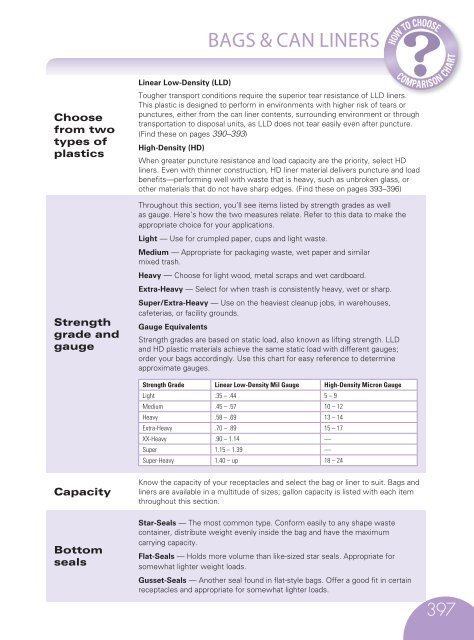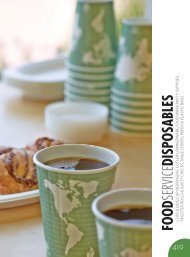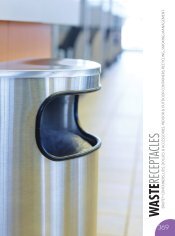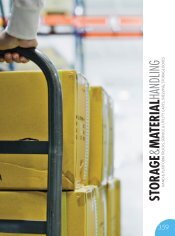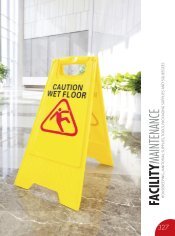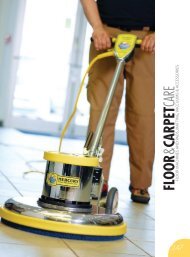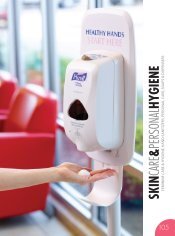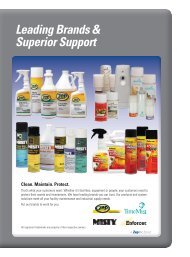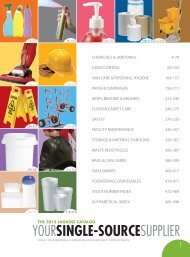CHRISTMAN CHEMICAL CO. INC. BAGS & CANLINERS CATALOG 2015
BAGS & CAN LINERS CATALOG 2015
BAGS & CAN LINERS CATALOG 2015
You also want an ePaper? Increase the reach of your titles
YUMPU automatically turns print PDFs into web optimized ePapers that Google loves.
<strong>BAGS</strong> & CAN LINERS<br />
Choose<br />
from two<br />
types of<br />
plastics<br />
Strength<br />
grade and<br />
gauge<br />
Linear Low-Density (LLD)<br />
Tougher transport conditions require the superior tear resistance of LLD liners.<br />
This plastic is designed to perform in environments with higher risk of tears or<br />
punctures, either from the can liner contents, surrounding environment or through<br />
transportation to disposal units, as LLD does not tear easily even after puncture.<br />
(Find these on pages 390–393)<br />
High-Density (HD)<br />
When greater puncture resistance and load capacity are the priority, select HD<br />
liners. Even with thinner construction, HD liner material delivers puncture and load<br />
benefits—performing well with waste that is heavy, such as unbroken glass, or<br />
other materials that do not have sharp edges. (Find these on pages 393–396)<br />
Throughout this section, you’ll see items listed by strength grades as well<br />
as gauge. Here’s how the two measures relate. Refer to this data to make the<br />
appropriate choice for your applications.<br />
Light — Use for crumpled paper, cups and light waste.<br />
Medium — Appropriate for packaging waste, wet paper and similar<br />
mixed trash.<br />
Heavy — Choose for light wood, metal scraps and wet cardboard.<br />
Extra-Heavy — Select for when trash is consistently heavy, wet or sharp.<br />
Super/Extra-Heavy — Use on the heaviest cleanup jobs, in warehouses,<br />
cafeterias, or facility grounds.<br />
Gauge Equivalents<br />
Strength grades are based on static load, also known as lifting strength. LLD<br />
and HD plastic materials achieve the same static load with different gauges;<br />
order your bags accordingly. Use this chart for easy reference to determine<br />
approximate gauges.<br />
Strength Grade Linear Low-Density Mil Gauge High-Density Micron Gauge<br />
Light .35 Ð .44 5 Ð 9<br />
Medium .45 Ð .57 10 Ð 12<br />
Heavy .58 Ð .69 13 Ð 14<br />
Extra-Heavy .70 Ð .89 15 Ð 17<br />
XX-Heavy .90 Ð 1.14 Ñ<br />
Super 1.15 Ð 1.39 Ñ<br />
Super-Heavy 1.40 Ð up 18 Ð 24<br />
Capacity<br />
Bottom<br />
seals<br />
Know the capacity of your receptacles and select the bag or liner to suit. Bags and<br />
liners are available in a multitude of sizes; gallon capacity is listed with each item<br />
throughout this section.<br />
Star-Seals — The most common type. Conform easily to any shape waste<br />
container, distribute weight evenly inside the bag and have the maximum<br />
carrying capacity.<br />
Flat-Seals — Holds more volume than like-sized star seals. Appropriate for<br />
somewhat lighter weight loads.<br />
Gusset-Seals — Another seal found in flat-style bags. Offer a good fit in certain<br />
receptacles and appropriate for somewhat lighter loads.<br />
397


